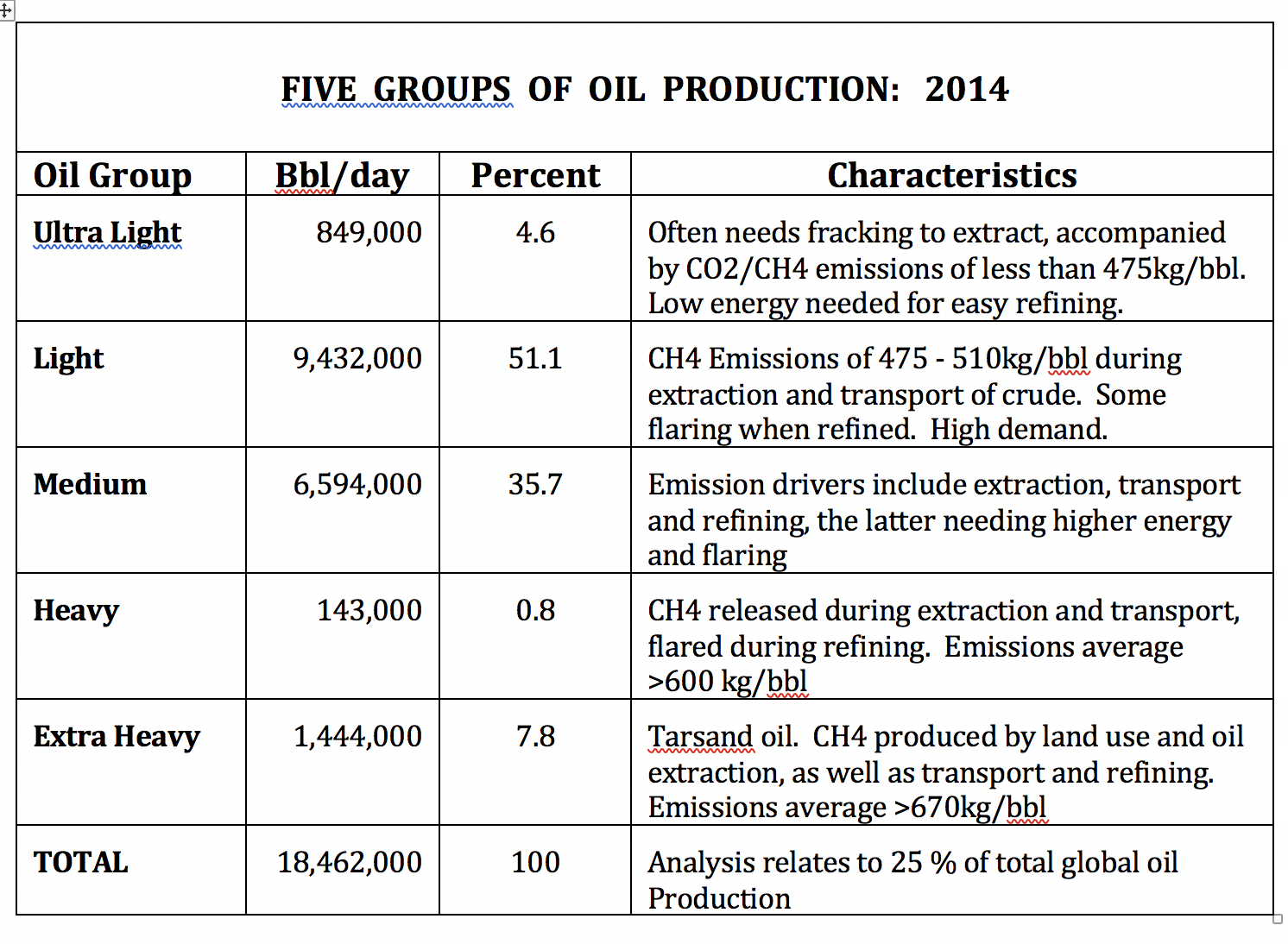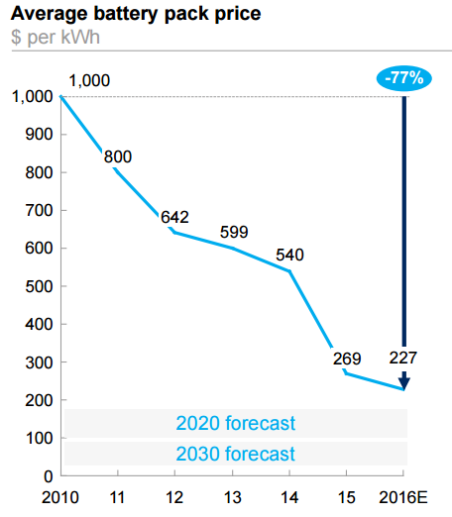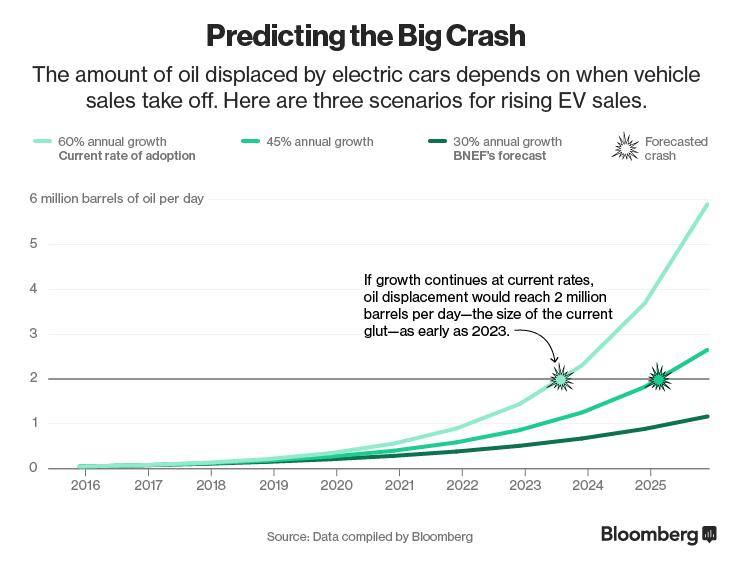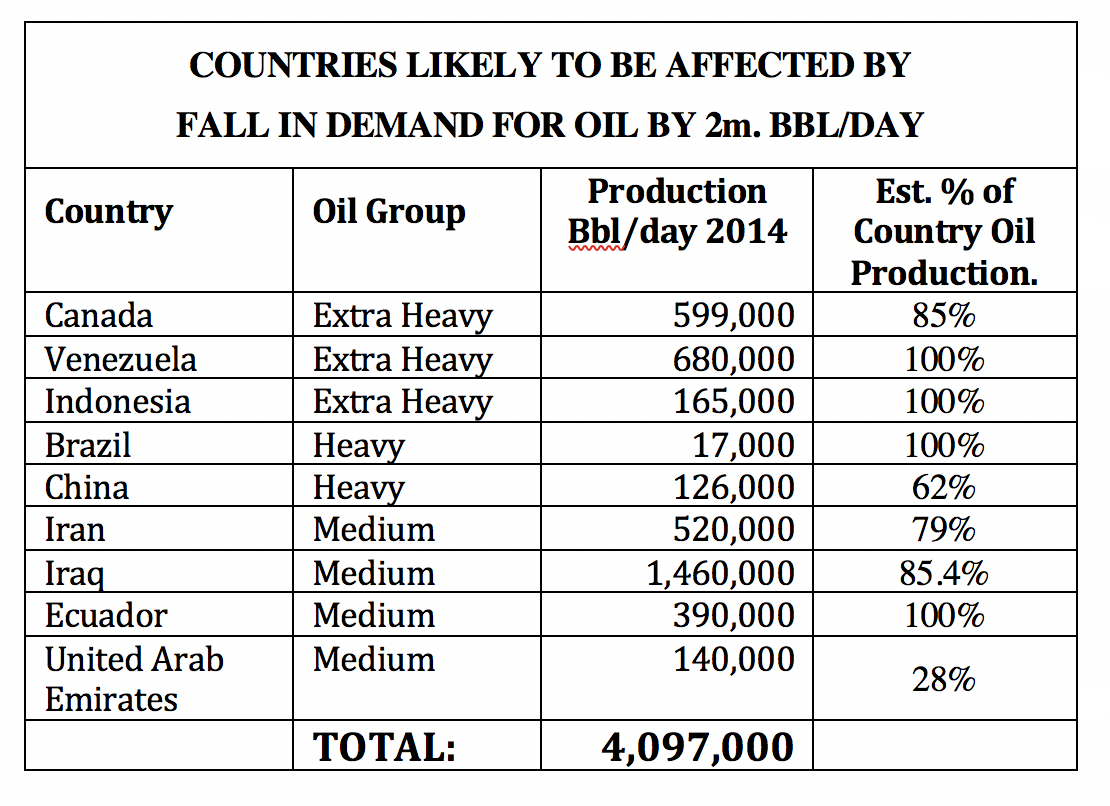Problems For Oil
Posted on 18 August 2017 by Riduna
The importance of oil should not be underestimated as an energy source – and a pollutant. Almost every form of transport is dependent on it and its refined products and the present economy would not have been created without it. Most of it is burned by vehicles propelled by the Internal Combustion Engine (ICE), enabling transport of people and goods world-wide. As the number of vehicles increases, so does demand for oil and its derivatives. Little wonder then that oil companies should regard their product as having a long, profitable and relatively secure future.
When it comes to talking about Peak Oil, we often think of it in terms of the point at which the yield from recoverable oil deposits begins to decline. With thawing in the Arctic, new oil deposits are likely to become available, giving the oil industry additional confidence that it will be able to sustain production for at least the next 50 years. Were the industry to think of Peak Oil in terms of the point at which demand for oil begins to decline, then its confidence in being able to sustain production for the next 50 years would seem misplaced for some, if not all kinds of oil.

Table 1. Showing difference in characteristics of the 5 groups of oil produced. Source: Data derived from the Carnegie Oil Climate Index covering 25% of global production in 2014.
Table 1 above shows oil is not a uniform product. Some oils are heavier, more difficult to extract and require greater energy to transport and refine. Lighter oils are easily pumped and refined and these oils are the most keenly sought by consumers. Were demand for oil to decline, the first to be affected would be those which are more expensive to extract and refine – the heavier oils – but ultimately all oil production would be affected by a sustained reduction in demand and this would have a significant affect on the economies of oil producing countries, particularly those most dependent on oil revenue.
Why would reduction in demand occur? Improvements have been made to the efficiency with which ICE vehicles burn fuel, thus lowering emissions but this has been off-set my an increase in the number of them in use. At present there are over 1 billion ICE vehicles in use with an additional 80 million vehicles being built each year. There has also been a trend towards production and refining of oils with higher emissions, particularly in North America. The problem with ICE vehicles are thee-fold:
- Oil and gas extraction and refining emit greenhouse gases, particularly methane (CH4) which over its 12 year lifetime in the atmosphere is far more potent than CO2:
- Combustion of oil-based fuels in ICE and jet engines emits CO2, Nitrous Oxides and CH4 contributing to global warming and:
- As a result of combustion, micro-particles are emitted to the atmosphere which are inhaled and impair human health, causing cancer and cardio-pulmonary diseases.
Globally, ICE engines are used in every sector – primary production, all forms of transport and in most other industries. They contribute ~33% of anthropogenic greenhouse gas emissions, making them a significant contributor to global warming, the formation of visible pollution (smog), and posing a danger to public health. This should place downward pressure on use of oil as an energy source but in fact the opposite is true. The present global glut of oil, caused by new drilling technology has enabled higher production, keeping the price of oil below US $60/barrel for the past two years and reducing income earned by oil producing countries.
Despite agreement among OPEC members to limit oil production in order to reduce the oil glut and increase per barrel price, the opposite has occurred because countries most dependent on oil sales as a source of national income (eg. Libya, Ecuador, Iran) have increased oil production in order to maintain national budgets. Petrol and diesel are more abundant and their price has fallen, encouraging their greater use, a trend aided by an increase in the number of road vehicles and likely to continue until 2020 when demand for oil products is expected to reach a maximum. Why should this trend not continue beyond 2020?
For the reasons noted above and on-going advances in battery technology enabling increasingly cost-effective storage of electricity which can replace internal combustion engines with electric motors, particularly in the transport sector. Importantly, these advances are starting to make it cheaper to generate dispatchable electricity from renewable sources, potentially displacing use of all fossil fuels as an energy source.
Race to be Cheapest
The number of electric hybrid and electric vehicles (EV’s) on our roads is presently constrained by their price which makes them more expensive than many ICE vehicles, primarily due to the cost of their batteries, the limited range they can be driven on a single charge and, to a lesser extent, the time they take to recharge. However, recent and on-going advances in technology continue to address these issues with the result that the purchase price of EV’s are destined to become highly competitive and, in less than a decade, cheaper than many ICE vehicles.
Batteries are the most expensive component in an EV so the price of these vehicles is largely dependent on battery costs falling, on their ability to store electricity rising – as well as on growth in uptake of EV’s by end users. Battery costs have fallen by more than 80% over the last 8 years while their energy density has increased the range of some EV’s from less than 100 km to around 400 km over the same period. These developments are being driven by competitive demand for improved EV’s and the growing need of solar and wind generators for greater storage capacity.

Fig 1. The widely available price for EV battery packs was $227 in 2016 but as noted below, in 2017 the price has declined to well below $200/kWh. Source: Elektrek.
For EV’s to sell at or below the price of ICE vehicles, the cost of batteries must fall to around $100/kWh. Tesla CEO Elon Musk claims that his megafactory (now 1 of many competing megafactories) has been producing EV battery-packs at less than $190/mWh since early 2016.
In 2017 there have been reports of recent EV battery sales at under $140/kWh, while Audi claims that battery packs for its up-coming electric car range will cost it around $114/kWh. It therefore seems possible that over the next 3 years battery capacity will enable most EV’s to travel a minimum of 500 km on a single charge. By 2020, battery prices are likely to have fallen further, possibly to less than $100/kWh.
This will make the purchase price of most EV’s competitive with ICE vehicles, stimulate accelerated uptake of EV’s and result in decline in demand for ICE vehicles and their fuels. Bloomberg suggest a sustained 45% compounding growth rate in uptake of EV’s in the 2020’s is likely.
These changes will be aided by the fact that EV’s are much cheaper to run and by public policy of supportive governments aimed at reducing fuel imports, saving foreign exchange and reducing greenhouse gas emissions. Evidence of this is provided by French and British Government announcements banning sale of ICE vehicles after 2040, a date which could be brought forward as technological advances are realized.
Competition among battery producers – and users – will ensure that the most cost-effective commercial batteries reach the market at the earliest date. Aluminium-air, solid state, even glass based innovations all offer significant improvements over lithium-ion batteries, both in terms of charge density and recharge time, the latter being reduced from hours to minutes and demand for them is particularly high, nowhere more so than in the transport sector.

Fig 2. Bloomberg analysts predict that uptake of EV’s will reduce demand for oil by 2 million barrels/day, possibly by 2023 and certainly by 2025. This is sufficient to cause a permanent and increasing reduction in demand for oil, placing downward pressure on its price, making it increasingly unprofitable to extract and refine.
Impacts
Most major motor vehicle builders now produce plug-in hybrid electric or purely electric vehicles, with Volvo becoming the first manufacturer to announce its intention of ceasing production ICE propelled cars. The trend away from ICE propulsion is very limited at present but will grow as EV battery prices decline and their storage capacity increases during the early 2020’s. The advent of autonomous vehicles could stimulate EV fleet sales since they are more profitable and safer to operate and can provide cheaper, more convenient transport to a population segment now dependent on taxi’s, car hire or public transport.
However the most significant impact of EV’s will initially be on those countries producing oil which is the most expensive to extract and refine, particularly those most dependent on oil exports and revenue for public expenditure. Those countries will experience rapid contraction of their oil markets and revenue earned from them. Some producers may, as they are presently doing, seek to off-set a fall in oil price and revenue by increasing production but this will only exacerbate a demand driven oil glut and accelerate price collapse.

Table 2: Countries most likely to be affected by reduction of 2 million bbl/day in demand for oil based on cost of extraction and refining. Source: Data derived from the Carnegie Oil Climate Index.
It is for this reason that some major oil producing countries, notably Saudi Arabia and Iran, are diversifying their economies, reducing their dependence on oil production and its revenue stream.
Ultimately - and more rapidly than many now think - oil production/refining companies will be faced with the need to contract or stop production, significantly reducing the value of their assets and ultimately, seeing them become stranded assets of little value followed by closure. Some countries (eg. China, Brazil) may continue production purely for domestic use. Others (eg Venezuela, Canada, Ecuador) are likely to see collapse of their heavier oil export markets.
Conclusions
- Production and use of oil poses risks to public health, is expensive and inefficient compared to electricity and contributors to global warming.
- It is likely that battery technology will significantly increase charge density, decrease recharge time and reduce costs to less than $100/kWh by 2020.
- This will make EV’s cheaper than ICE vehicles resulting in rapid and sustained growth in EV uptake, reducing demand for oil-based fuels.
- By 2023 it is possible that demand for oil-based fuels will have reduced by 2 million bbl/day, resulting in a continually growing global oil glut.
- This is likely to cause oil producers/refineries to scale down their operations and, as the glut grows, to close-down.
- The oil glut will initially cause fall in demand for heavier oils listed in Table 2 and, as EV uptake gains momentum, medium and lighter oils.
- By 2025 it is likely that CO2 emissions from oil production, refining and use will be reduced by at least 470 million tonnes/annum.
- By 2035 it is possible that global demand for oil could decrease, by up to 50% from predicted peak demand level expected in 2020.
Advances in battery technology now being made will have a much wider effect than curbing use of oil for transport. They herald an all pervasive, permanent change from reliance on fossil fuels as our prime source of energy to electricity generated from solar, wind, tidal and geothermal sources, stored for optimal use.































 Arguments
Arguments






























The best way to get more done to reduce emissions might be to put more emphasis on the advantages of electric cars and renewable energy. I don't mean in any way stop discussing the latest science or denialist myths, but just as a general strategy for anyone interested in the climate issue.
The following article is a formidable analysis of just how political climate denialism has become, and how rigid it is, and reasons why. Focussing on renewable energy and electric cars might effectively help side step political conflicts that are not going to go away too easily. Most people respond to lower running costs, quieter more reliable cars, etc.
thespinoff.co.nz/science/climate-change-week/18-08-2017/climate-change-is-happening-but-dont-bother-trying-to-convince-a-denier/
However theres one sticking point. As prices of oil drop this may encourage petrol cars in the shorter term.
And better batteries are crucial. In fact range is already looking quite good, but Im thinking heating.
In the second sentence of the Conclusions, shouldn't it be "increase charge density, descrease recharge time, and reduce costs"?
Digby - Yes it should be. Thanks
President Trump is saving jobs in the oil, gas, etc, sections, so it looks as if oil, etc is here to stay for a while. If one could get oil to enhance tree growing and offset some of the problems that might be the best in the short term. People have proposed the solar energy updraft tower as a mechanism for convectional rain formation (warm moist air from greenhouses at the base of the tower, etc) and one could grow trees in arid ares if rain would fall there. Although people have been advocating solar updraft towers, so far not much has been done. The present design has a greenhouse at the bottom providing hot air. My concern is that air does not come into intimate contact with hot surfaces with a greenhouse and if the hot air is not transferred quickly, there will be heat losses through the glass of a greenhouse and so on. Air is not heated much by radiation, but it is heated efficiently by direct contact with hot surfaces. I therefore propose that solar air heaters be used for the base of the solar updraft towers, rather than greenhouses. With greater efficiency one would not have to have such a large area (the greenhouse needs a huge area). Also, with solar air heaters, the heaters can be mounted vertically on poles saving huge space. Perhaps a smaller greenhouse at the base with seawater with the sole purpose of mistening air and solar air heaters mounted on poles would supply convectional rain and trees could be grown with the rain. Hot eserts are ideal places because there is space to grow trees and a lot of solar energy. Then oil and gas could possibly be phased out or used to heat water for the solar updraft towers.
Swayseeker @4
I respect your technical knowledge, but these are dubious ideas not properly thought through, not likely to make a significant difference, not likely to be cost effective, not practical, and just circulates CO2 around the system when we are trying to actually reduce fossil fuel use. Not likely to be supported by climate denialist "President" Trump.
You have promoted similar stuff before, and it was explained why it doesn't make sense. Do you not listen to feedback?
My guess is that there will be a sort of hockey stick line in the EV take-up numbers. (With apologies to Michael Mann)
As more and more cars are EVs the demand for gasoline will obviously fall and as a result there will be a rise in the number of filling stations able to remain profitable.
As it becomes more difficult to find gas stations and with greater accessibility to charging points I reckon there'l be a near vertical end to the EV hockey stick.
I mean, of course, "Fall" rather than "Rise".
Read before pressing "submit".......
Swayseeker@4
How is oil supposed to enhance tree growth?
The fact is trees are vulnerable to human activity as much as mammals, birds etc. That isn't going to change. Creating fake environments is just a further development of humans displaying their god like intentions (control and domination of everything), on top of many other existing human activities.
The basic and only way forward is for humans to fit in with the basic natural processes. As far as energy goes, that is solar energy, tidal energy and maybe geothermal. Wind and wave energy are effectively second and third hand solar energy.
Hi Riduna. Great article, thank you. Being a cautious type though, please tell me something about who you are and what your qualifications are. Thanks!
"who you are and what your qualifications are"
Why does that matter at all? The article cites sources.
China leads the world with sale of 507,000 EV’s, compared to 222,000 EV’s sold in Europe in 2016. In the USA, 157,000 EV’s were purchased, up 36% on 2015. All major vehicle builders now include or will soon launch an EV alternative.